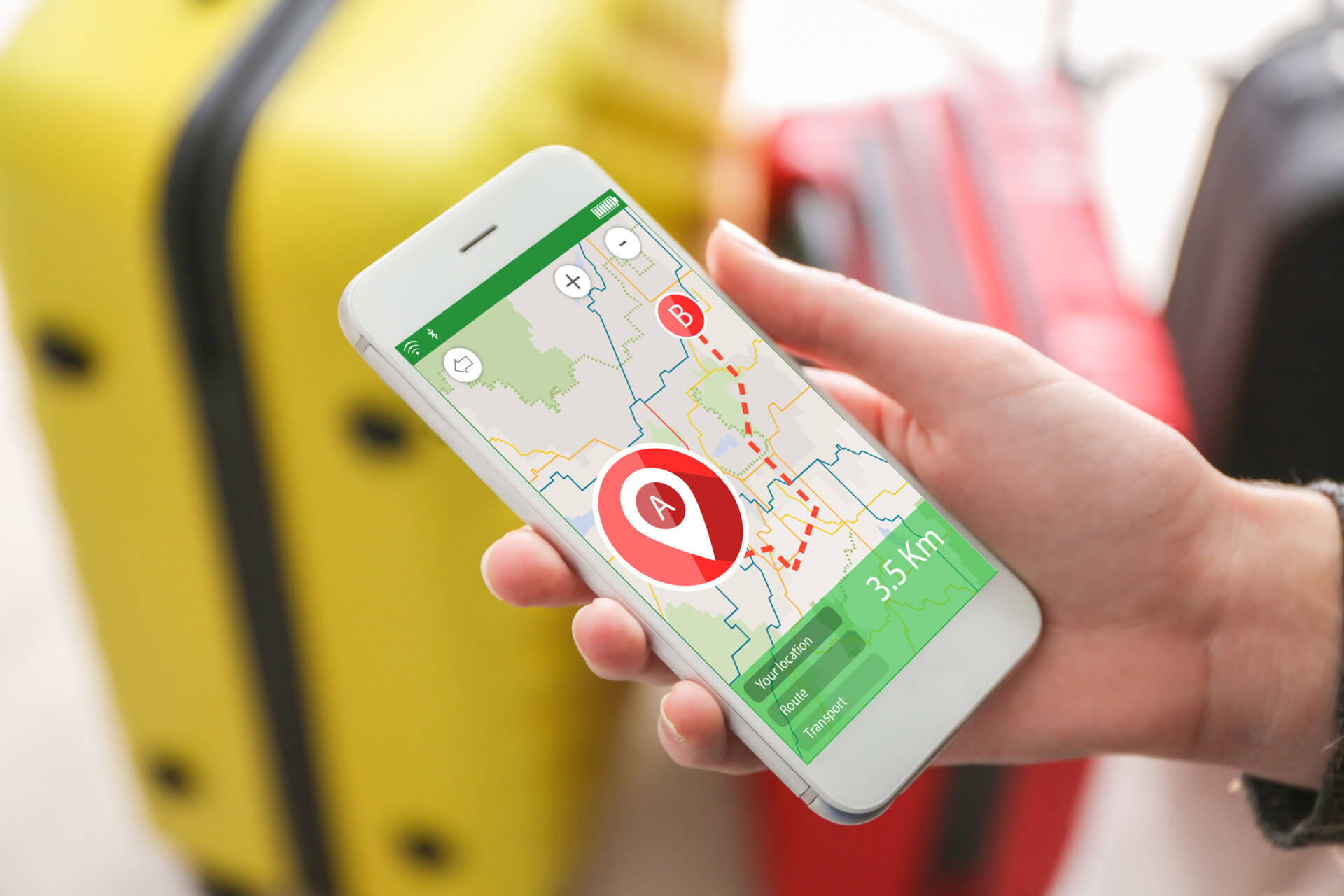
L’été est là et les vacances approchent. Nous sommes des millions à nous presser dans les aéroports pour des destinations plus ou moins lointaines. Et parmi nous, les personnes aveugles ou malvoyantes aussi ! Comment se rendre au terminal de départ, se repérer dans ces espaces disproportionnés, atteindre leur comptoir d’enregistrement puis la porte d’embarquement ? Outre les services d’assistance aux passagers, les technologies offrent de plus en plus de possibilités de se déplacer de manière autonome et de profiter des services d’un aéroport au même titre que tout autre passager aérien. À condition de prendre en compte les besoins spécifiques de chacun, et c’est ce que nous abordons plus en détail dans cet article.
Assistance aéroportuaire pour les voyageurs handicapés ou à mobilité réduite
Les personnes aveugles ou malvoyantes qui décident de voyager seules en avion peuvent bénéficier de l’assistance aéroportuaire. Il leur suffit d’indiquer leur besoin d’assistance guidée lors de la réservation de leur vol ou en contactant directement le service au moins 48 heures à l’avance.
Avec le règlement (CE) n° 1107/2006 du Parlement européen et du Conseil du 5 juillet 2006 concernant les droits des personnes handicapées et des personnes à mobilité réduite lorsqu’elles font des voyages aériens, l’Union européenne a transféré la responsabilité de l’assistance aux passagers aux aéroports. Dans certains pays, comme les États-Unis, cette responsabilité reste toutefois du ressort des compagnies aériennes, ce qui entraîne des niveaux de service très disparates.
Un personnel d’assistance spécialisé peut aider les personnes handicapées dès le comptoir d’enregistrement, jusqu’à l’embarquement et à l’arrivée . Les voyageurs aveugles ou malvoyants sont ensuite accompagnés pour passer les contrôles de sécurité et rejoindre la porte d’embarquement.
Atteindre le point d’assistance de l’aéroport : une difficulté majeure pour une personne aveugle
Bien que l’assistance spéciale commence au comptoir d’enregistrement, comment s’y rendre si vous êtes malvoyant ou aveugle ? Le trajet aller-retour entre le point de transit et le point de dépôt peut être long et semé d’embûches.
Une solution consiste à installer des bornes d’appel à proximité de ces points d’arrêt afin que les voyageurs handicapés ou à mobilité réduite puissent signaler leur présence au personnel d’assistance spécialisé. C’est ce qui préconise la réglementation européenne. Mais comment trouver ces bornes d’appel lorsqu’on ne les voit pas ? Pour être facilement localisables, les bornes d’appel doivent :
⊗ Être visuellement contrasté avec leur environnement
⊗ Être identifiable par une balise audio activée à distance
⊗ Être balisé par un chemin tactile.
Il faudra également veiller à la simplicité et à la convivialité : bouton d’appel bien visible et maniable, retour sonore pour confirmer la prise en compte de l’appel, qualité audio pour la communication.
Applications de navigation intérieure pour les personnes aveugles et malvoyantes
Enregistrer ses bagages, passer le contrôle de sécurité, se rendre à la porte d’embarquement puis à l’avion : l’assistance humaine permet d’accomplir tout ce parcours facilement et sans stress. Or, les personnes aveugles et malvoyantes aspirent à bénéficier des mêmes services que les autres voyageurs : aller aux toilettes, se restaurer, faire des achats… C’est d’autant plus important lorsque la succession des vols implique une longue attente. De plus, le recours à l’assistance aéroportuaire nécessite une anticipation parfois difficile (offres de voyage de dernière minute, voyages d’affaires imprévus, urgences familiales, etc.). C’est pourquoi pouvoir se déplacer de manière autonome dans un aéroport avec une déficience visuelle est un enjeu crucial.
De nombreux aéroports internationaux, comme ceux de Paris, Copenhague ou Houston, proposent des applications de navigation intérieure sur smartphone pour guider les voyageurs dans leurs locaux. Ces applications reposent généralement sur des balises Bluetooth basse consommation réparties dans le bâtiment, ces mêmes balises pouvant transmettre des informations contextualisées.
Mais contrairement à ce qui existe aujourd’hui, pour guider les personnes malvoyantes, ces applications doivent prendre en compte leurs besoins spécifiques.
L’interface utilisateur :
L’application doit être entièrement compatible avec les lecteurs d’écran (VoiceOver pour iOS et TalkBack pour Android) et les options de zoom et de confort des smartphones. Tous les boutons, listes et autres éléments de navigation doivent être soigneusement étiquetés avec un texte explicite.
Différentes méthodes de saisie doivent être disponibles : saisie classique, dictée vocale ou saisie braille à l’écran.
Instructions:
Les personnes malvoyantes n’ont généralement pas la capacité de se référer à une carte ou à une signalisation visuelle. Les directions doivent donc être indiquées en fonction de la position de l’utilisateur, soit à l’aide du cadran de l’horloge, soit en degrés.
Points de repère spécifiques :
Les personnes aveugles ou malvoyantes s’appuient sur des repères différents des autres voyageurs. Il s’agit essentiellement de repères tactiles ou sonores. Ainsi, les descriptions d’itinéraires fournies par l’application doivent mentionner ces éléments de manière précise : chemins de guidage tactiles, indicateurs d’avertissement, balises sonores… Ces éléments physiques permettent également de confirmer sa position et d’être rassuré sur le bon déroulement de l’itinéraire.
Précision de l’orientation :
Bien qu’il soit possible pour les personnes voyantes de corriger l’imprécision de la navigation en jetant un coup d’œil à la signalisation et à leur environnement, cela est beaucoup plus compliqué pour les personnes malvoyantes ou aveugles. La précision de la localisation est donc un facteur important pour guider un itinéraire et atteindre la destination souhaitée. Mais ce n’est pas le seul ! Les technologies actuelles n’offrent pas une précision d’un mètre près. Afin de répondre aux objectifs de mobilité des utilisateurs finaux, d’assurer un guidage précis et de les mener à destination, d’autres critères entrent en jeu, notamment la précision des instructions données. L’escalier monte-t-il ou descendre-il ? Combien de marches ? Tourne-t-il à droite ou tourne-t-il ? Y a-t-il une porte ? Une ouverture manuelle ou automatique ?
L’implication des utilisateurs finaux dans le projet
Enfin, l’application doit être personnalisable, car les besoins et les préférences des utilisateurs varient d’une personne à l’autre en fonction de leurs capacités visuelles restantes, de leur expérience et de leurs aptitudes. Tout projet d’application d’orientation doit faire l’objet d’une consultation des utilisateurs finaux afin d’identifier leurs besoins, mais aussi d’expérimentations in situ en cours de développement pour valider le bon fonctionnement du système.
Aujourd’hui, l’expertise acquise par les professionnels de la mobilité des personnes handicapées et la maturité des technologies permettent d’envisager des solutions efficaces pour guider les personnes déficientes visuelles. C’est l’occasion de leur offrir un accès égal à tous les services et une liberté de choix dans leur vie quotidienne, afin de leur permettre de participer pleinement à la vie économique et sociale.
media

Special assistance starts at the check-in desk. How do you get there if you have low or no vision? Traveling to and from the transit point or the drop-off can be long and fraught.
writer

Lise Wagner
Accessibility Expert
stay updated
Get the latest news about accessibility and the Smart City.
other articles for you

Open Data Is Key to Fostering Universal Accessibility
Open data represents an opportunity for cities to reach universal accessibility. It shows the missing links of the mobility chain.
Our Audio Beacons Guide the Blind and Visually Impaired at the Helsinki Subway
The Helsinky subway improved their audio signage system by installing on demand and remotely activated audio beacons.
7 Good Reasons to Install Audio Beacons at Your Public Transport Network
Audio beacons are an efficient way to provide more autonomy to blind and visually impaired people. They can easily use public transport.

Will Remote Activation Become the Norm for Accessible Pedestrian Signals?
More and more cities like New York have been exploring remote activation to trigger accessible pedestrian signals.
share our article!
more articles

Disability Statistics in the US: Looking Beyond Figures for an Accessible and Inclusive Society
Disability Statistics in the US: Looking Beyond Figures for an Accessible and Inclusive Society Around 61 million adults in the United States live with a disability. Diving into disability statistics in the US will help us know exactly who is concerned and what...
Our Audio Beacons Guide the Blind and Visually Impaired at the Helsinki Subway
Our Audio Beacons Guide the Blind and Visually Impaired at the Helsinki SubwayOur audio beacons equip the new line of the Helsinki subway in Finland. They help blind and visually impaired people locate the points of interest of a station. For users with visual...

Will Remote Activation Become the Norm for Accessible Pedestrian Signals?
Will Remote Activation Become the Norm for Accessible Pedestrian Signals?Without pushbutton, there are no accessible pedestrian signals. That’s how APS work in the U.S. But more and more cities have been exploring remote activation like New York City. The Department...

Hearing Impaired People: a Multitude of Profiles for Different Needs
Hearing Impaired People: a Multitude of Profiles for Different Needs Did you know that hearing impaired people have several profiles and that the way they identify themselves is important? You may be familiar with deaf and hard of hearing people but for each of...
NEVER miss the latest news about the Smart City.
Sign up now for our newsletter.
Unsubscribe in one click. The information collected is confidential and kept safe.
powered by okeenea
The French leading company
on the accessibility market.
For more than 25 years, we have been developing architectural access solutions for buildings and streets. Everyday, we rethink today’s cities to transform them in smart cities accessible to everyone.
By creating solutions ever more tailored to the needs of people with disabilities, we push the limits, constantly improve the urban life and make the cities more enjoyable for the growing majority.


